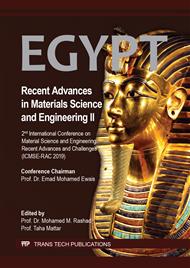p.317
p.324
p.335
p.347
p.353
p.359
p.367
p.374
p.384
Effect of Nano ZrO2 Additions on the Mechanical Properties of Ti-12Mo Composite by Powder Metallurgy Route
Abstract:
Ti-12Mo/ZrO2 nanocomposites are fabricated using the powder metallurgy technique for the potential of aerospace applications. Titanium-12 wt. % molybdenum metal matrix composite containing various percentages of ZrO2 (5, 10, and 15 wt. %) are prepared. The phase composition and microstructure of Ti-12Mo/ZrO2 powder, as well as the consolidated composites), are investigated by both X-ray diffraction and scanning electron microscope (SEM) equipped with an energy dispersive spectrometer (EDS) respectively. All the consolidated composites are characterized by measuring the density, Vickers hardness, and wear rate. XRD refers to no new phase are formed between Ti, Mo, and ZrO2 during the sintering process. Also, a good microstructure is achieved. Results indicated that the density of the sintered composites is increased with increasing ZrO2 percent up to 5 wt. %. On the other hand, the highest hardness and highest wear resistance are achieved for 5 wt. % ZrO2 sample. The present work demonstrated that Ti-12Mo/ZrO2 composites have a high potential for aerospace applications.
Info:
Periodical:
Pages:
367-373
Citation:
Online since:
March 2020
Price:
Сopyright:
© 2020 Trans Tech Publications Ltd. All Rights Reserved
Share:
Citation:


